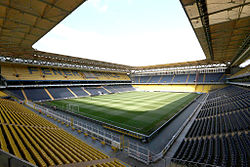Top Qs
Timeline
Chat
Perspective
Şükrü Saracoğlu Stadium
Football stadium in Istanbul, Turkey From Wikipedia, the free encyclopedia
Remove ads
The Şükrü Saracoğlu Stadium (Turkish pronunciation: [ˈʃycɾy saɾaˈdʒoːɫu]), known for sponsorship reasons as Chobani Stadium Fenerbahçe Şükrü Saracoğlu Sports Complex (Turkish: Chobani Stadyumu Fenerbahçe Şükrü Saracoğlu Spor Kompleksi), or simply Chobani Stadium, is a football stadium located in the Kadıköy district of Istanbul, Turkey. It is the traditional home venue of major Turkish multi-sport club Fenerbahçe S.K. since its opening in 17 September 1908[8][9]
This stadium holds the distinction of being the first venue in the Ottoman Empire to host mass sporting (especially football) events. As such, it is a prime example of the sports build culture that has been transmitted to Modern Turkey.[8] It was inaugurated in 17 September 1908 and renovated between 1929 and 1932, 1965 and 1982, and finally 1999 and 2006.[10] It is one of the highest capacity stadiums in Turkey. Named after Şükrü Saracoğlu, one of Fenerbahçe S.K.'s longest-serving presidents and an important statesman who was also both the Prime Minister (1942–1946) and the Foreign Minister (1938–1942) of Turkey.[11] On 4 October 2006, after numerous inspections by UEFA, Şükrü Saracoğlu Stadium (in 2009, coinciding with the 101st anniversary of its opening) was selected to host the 2009 UEFA Cup Final[12][13] that went down in history as the last Final of the UEFA Cup football tournament, which was rebranded as the UEFA Europa League starting from the 2009–10 season.[14][15][16]
Remove ads
History
Summarize
Perspective

Before the stadium was built, the field was known as Papazın Çayırı (lit. 'the priest's meadow'). The field, however, became the very first official association football pitch of Turkey, where the first league games of the Istanbul Football League were all held consecutively. Until the Young Turks proclaimed the 2nd Constitutional Era in 1908 — a milestone that sparked profound socio-political change within Ottoman society — this green area had long been part of the Sultan’s private estate. That same year, a group of passionate sportsmen, led by Nurizade Ziya Songülen (the founder and first president of Fenerbahçe) and Cemil Topuzlu (then the physician to Abdul Hamid II), launched an initiative to secure land in Istanbul dedicated to football activities. After careful consideration, they chose this very plot as the ideal location. In 1908, the local teams in the league needed a regular football field, so this land was leased from the Sultan of Ottoman Empire Abdul Hamid II for 30 Ottoman gold pounds a year. The total construction cost was 3,000 Ottoman gold pounds. The stadium that was established at that time was named ‘Union Club Field’ by a group of sports enthusiasts led by Ziya Songülen, the founding president of Fenerbahçe, together with Cemil Topuzlu and Reji Whittall — one of the earliest figures to play football within the Ottoman Empire. The name was derived from the ‘Union Club' an organization which, in essence, functioned as the football federation of that era.[17]
The Union Club Field was used by many teams in İstanbul, including the owner, Union Club (which changed its name to İttihatspor after World War I), Fenerbahçe, Galatasaray, and Beşiktaş. However, it lost its importance when a bigger venue, the Taksim Stadium, was built in 1922, inside the courtyard of the historic Taksim Topçu Kışlası (Taksim Artillery Barracks), which was located at the present-day Taksim Gezi Parkı (Taksim Park).[citation needed]
İttihatspor (which had close relations with the political İttihat ve Terakki), was forced to sell it to the state, in which Şükrü Saracoğlu (1887–1953) was a member of the CHP government. Thus, the ownership of the stadium passed to the state, but the field was immediately leased to Fenerbahçe. Later, on 27 May 1933, Fenerbahçe purchased the stadium from the government when Şükrü Saracoğlu was the President of Fenerbahçe, for either the symbolic amount of ₺1[18] or the worth of the stadium which was ₺9,000.[19]
The name of the field was changed to Fenerbahçe Stadium, and this made Fenerbahçe SK the first football club in Turkey to own their stadium, with the help of the Şükrü Saracoğlu government. In the following years, Fenerbahçe S.K. renovated the stadium and increased its seating capacity. By the year 1949, Fenerbahçe Stadium was the largest football venue in Turkey, with a seating capacity of 25,000.[20]

The name of the stadium was changed once more in 22 July 1998, becoming Fenerbahçe Şükrü Saracoğlu Stadium, named after Fenerbahçe's legendary chairman (1934–1950) and Turkey's fifth prime minister Şükrü Saracoğlu. In 1999, the latest round of renovations and capacity increasing projects started. The stands on the four sides of the stadium were torn down one at a time, as the Turkish Super League seasons progressed, and the entire renewal and construction project was finalised in 2006.[9] As of 3 August 2015, Ülker secured naming rights of the stadium in a 10-year deal worth $90 million officially renaming the stadium Ülker Stadium Fenerbahçe Şükrü Saracoğlu Sports Complex.[21] Chobani secured naming rights of the stadium in 30 July 2025. Fenerbahçe S.K. and Chobani have reached an agreement on stadium naming sponsorship, starting from the 2025–26 season, for 5+5 seasons, i.e. a total of 10 years, with a payment of €10 million per season.[22]

Remove ads
Artworks
A number of artworks are placed in front of the stadium:
Gallery
- Stadium entrance
- Interior view
- Interior view
- Interior view
- Interior view
- A view from the stadium
- Interior view
- Interior view
- Interior view
- Interior view
- Interior view
References
External links
Wikiwand - on
Seamless Wikipedia browsing. On steroids.
Remove ads













